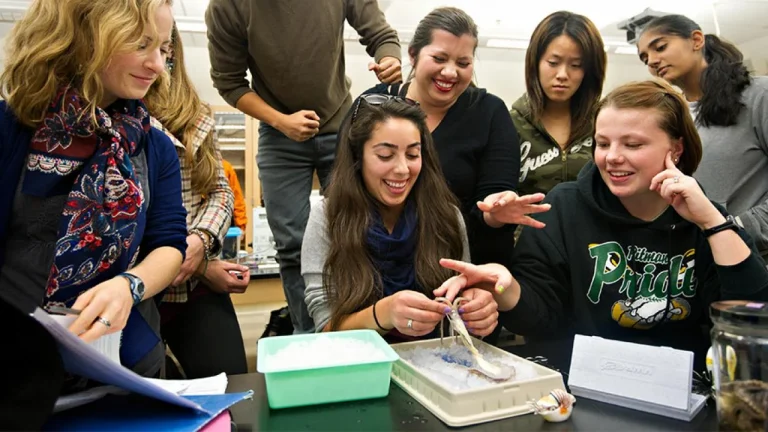Does Environmental Science Have Math?
From analyzing pollution levels to modeling climate change, environmental science plays a crucial role in understanding and protecting our planet. But how much math does an environmental science career actually involve? Let’s dig into the numbers.
If you’re short on time, here’s a quick answer: Yes, environmental science relies heavily on mathematical concepts and skills for gathering, analyzing, and making sense of complex data.
In this approximately 3000 word article, we’ll look at the specific areas of math used in environmental science, examine common math course requirements, and explore careers for non-math experts.
Key Mathematical Concepts in Environmental Science
Statistics
Statistics plays a crucial role in environmental science by helping researchers analyze and interpret complex data sets. From studying the effects of pollution on air quality to analyzing population trends in endangered species, statistical analysis allows scientists to draw meaningful conclusions from their research.
By using statistical techniques such as regression analysis and hypothesis testing, environmental scientists can identify patterns, make predictions, and assess the significance of their findings. For example, statisticians can determine the correlation between pollution levels and respiratory diseases, helping policymakers develop effective strategies to improve air quality.
For more information on statistical techniques used in environmental science, you can visit EPA’s website.
Calculus
Calculus is another mathematical concept that finds applications in environmental science. It is particularly useful for studying rates of change and understanding processes that occur over time. Environmental scientists use calculus to model and analyze various phenomena, such as the rate of water flow in rivers, the growth of plant populations, and the spread of pollutants in ecosystems.
By applying calculus principles, scientists can quantify these processes and make predictions about future trends.
One example of calculus in environmental science is the calculation of the instantaneous rate of change in pollutant concentration in a water body. This information helps scientists assess the impact of pollution and develop strategies for its mitigation.
Differential Equations
Differential equations are mathematical equations that describe how quantities change over time. In environmental science, these equations are used to model and understand complex systems. For instance, differential equations can be employed to study the dynamics of predator-prey relationships, the spread of infectious diseases, or the behavior of chemical reactions in the environment.
By solving these equations, scientists can gain insights into the behavior of these systems and make predictions about their future states.
By using differential equations, researchers can model the interaction between a predator and its prey, such as the relationship between wolves and caribou. This helps in understanding the impact of changes in predator or prey populations on the overall ecosystem.
Mathematical Modeling
Mathematical modeling is a key component of environmental science as it helps scientists simulate and predict complex environmental phenomena. By using mathematical equations and computer simulations, researchers can model the behavior of ecosystems, climate systems, and pollution dispersion patterns.
These models provide valuable insights into the potential impacts of human activities on the environment and help in developing strategies for sustainable resource management.
One example of mathematical modeling in environmental science is the development of climate models that simulate the Earth’s climate system. These models help scientists understand the causes and effects of climate change, allowing for informed decision-making and policy development.
So, yes, environmental science does have math! It is through the application of mathematical concepts such as statistics, calculus, differential equations, and mathematical modeling that scientists are able to gain a deeper understanding of environmental processes and make informed decisions to protect our planet.
Math Course Requirements for Environmental Science Degrees
Undergraduate Programs
Mathematics plays a crucial role in the field of environmental science, as it provides the necessary tools for data analysis, modeling, and problem-solving. Undergraduate programs in environmental science typically require students to take a certain number of math courses to develop these skills.
These courses may include calculus, statistics, algebra, and geometry. By studying these mathematical concepts, students gain the ability to analyze environmental data, make predictions, and understand complex systems.
Master’s Programs
In master’s programs in environmental science, the level of mathematical rigor may increase. Students are often required to take advanced courses in statistics, data analysis, and modeling. These courses help students develop a deeper understanding of mathematical principles and their applications in environmental research.
Additionally, master’s programs may also offer specialized courses in mathematical modeling, where students learn to create mathematical representations of environmental systems and analyze them using computational methods.
PhD Programs
PhD programs in environmental science often require a strong mathematical background. Advanced coursework in statistics, calculus, and differential equations may be essential for conducting research at the doctoral level.
In addition to these core math courses, PhD students may also take specialized courses in mathematical ecology, spatial analysis, or computational modeling. These courses enable students to tackle complex research questions and develop innovative solutions to pressing environmental issues.
Environmental Science Careers for Non-Math Majors
Many students who are passionate about the environment may worry that a lack of math skills will hinder their ability to pursue a career in environmental science. While math is an important component of the field, there are numerous career paths available for non-math majors.
These careers allow individuals to make a positive impact on the environment without requiring advanced mathematical knowledge.
Environmental Educator
One career option for non-math majors in the field of environmental science is becoming an environmental educator. Environmental educators work in schools, nature centers, parks, and other educational institutions to teach students and the public about environmental issues and conservation.
Their role is to inspire and educate others about the importance of protecting the environment.
While a solid foundation in science is important for this career, advanced mathematical skills are not typically required. Instead, environmental educators focus on developing engaging and interactive lessons and activities that help others understand and appreciate the natural world.
They may use hands-on experiments, field trips, and multimedia presentations to convey their message effectively.
Conservation Scientist
Another career path for non-math majors in environmental science is that of a conservation scientist. Conservation scientists work to protect and manage natural resources, such as forests, wildlife habitats, and water sources.
They conduct research, analyze data, and develop strategies to promote sustainable practices and protect the environment.
While some mathematical skills may be useful in this career, they are not typically the focus of the job. Conservation scientists primarily rely on their knowledge of biology, ecology, and environmental science to assess the health of ecosystems, identify potential threats, and develop conservation plans.
They may work closely with other experts, such as statisticians or mathematicians, to analyze data, but their role is primarily focused on the ecological aspects of conservation.
Environmental Writer
For those who have a passion for both the environment and writing, a career as an environmental writer may be a great fit. Environmental writers use their writing skills to inform and educate the public about environmental issues, conservation efforts, and sustainable practices.
They may work for magazines, websites, non-profit organizations, or government agencies.
While research and critical thinking skills are essential for this career, advanced mathematical knowledge is typically not required. Environmental writers focus on crafting compelling narratives, explaining complex concepts in a clear and accessible way, and highlighting the importance of environmental stewardship.
They may interview experts, conduct research, and visit environmental sites to gather information for their articles.
It’s important to note that while these careers do not require advanced mathematical skills, a basic understanding of math is still beneficial in the field of environmental science. It can help individuals analyze and interpret data, understand scientific studies, and make informed decisions.
However, a lack of math proficiency should not discourage non-math majors from pursuing a career in environmental science. There are plenty of rewarding and impactful roles available that focus more on the ecological and educational aspects of the field.
Developing Relevant Math Skills for Environmental Science
When it comes to environmental science, math plays a crucial role in understanding and analyzing various environmental phenomena. Developing strong math skills is essential for students pursuing a career in this field.
Let’s explore some of the key areas where math is applied in environmental science.
Introductory Statistics
Introductory statistics is a fundamental course that provides students with the tools to analyze and interpret data. In environmental science, statistical analysis is used to examine trends, patterns, and relationships in the data collected from environmental samples and experiments.
This allows scientists to draw meaningful conclusions and make informed decisions based on the data they have collected. Understanding statistical concepts such as probability, hypothesis testing, and regression analysis is vital for conducting accurate and reliable environmental research.
Calculus Courses
Calculus courses, including both differential and integral calculus, are essential for understanding the dynamic processes of environmental systems. Calculus helps in modeling and predicting changes in variables such as population growth, pollutant dispersion, and energy flow.
For example, calculus is used to study the rate at which pollutants disperse in the atmosphere or the rate at which a population of organisms grows in a given environment. By applying calculus, environmental scientists can make predictions and develop strategies to manage and mitigate environmental issues.
Math Modeling Practice
Mathematical modeling is a powerful tool used in environmental science to simulate complex systems and predict their behavior. It involves formulating mathematical equations that represent the interactions between different components of an environmental system.
These models can be used to assess the impact of human activities, simulate the spread of diseases, or evaluate the effectiveness of environmental policies. Developing proficiency in math modeling helps environmental scientists make informed decisions and design effective strategies for sustainable environmental management.
Getting Comfortable Applying Math Concepts
When it comes to environmental science, math plays a significant role in understanding and analyzing data. Many students may initially feel intimidated by the idea of incorporating math into their studies, but getting comfortable with applying math concepts is essential for success in this field.
Relate Math to Real-World Data
One way to ease into using math in environmental science is by relating it to real-world data. By connecting mathematical concepts to tangible examples, students can better understand the relevance and practicality of using math in this field.
For example, understanding how to calculate the rate of deforestation or the impact of pollution on a specific ecosystem requires mathematical skills. By visualizing how math can help solve real-life environmental problems, students can develop a deeper appreciation for its importance.
Practice Calculating and Analyzing Results
Another way to become comfortable with math in environmental science is through practice. Regularly calculating and analyzing results helps students strengthen their mathematical skills and learn how to interpret data accurately.
Whether it’s measuring water quality, analyzing air pollution levels, or modeling climate change patterns, math provides the tools necessary to make informed decisions and predictions. By actively engaging with math in a practical context, students can build confidence and become proficient in applying mathematical concepts to environmental science.
Collaborate with Math-Minded Colleagues
Collaboration is key in any field, and environmental science is no exception. Working with math-minded colleagues can be incredibly beneficial for those who may feel less confident in their mathematical abilities.
By teaming up with individuals who excel in math, students can learn from their expertise and gain a deeper understanding of how math is applied in environmental science. This collaboration not only enhances learning but also fosters a supportive and encouraging environment for tackling challenging math concepts.
Remember, math is a powerful tool that can enhance our understanding of the environment and help address complex environmental issues. By getting comfortable with applying math concepts, students can unlock a world of possibilities and contribute to the field of environmental science in meaningful ways.
Conclusion
While advanced environmental science research requires complex mathematical proficiency, basic math skills empower professionals to assess ecological trends and promote sustainability. By mastering environmental statistics and calculations, non-math majors can contribute to resolving today’s urgent environmental challenges.
With a foundation in math concepts relevant to real-world problems, a passion for environmental science can evolve into a rewarding and impactful career.







